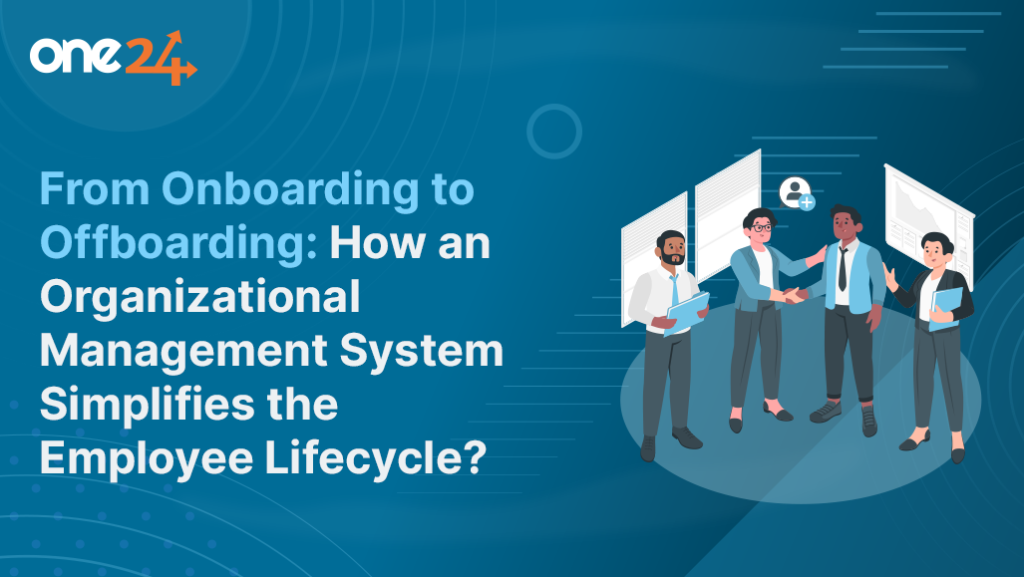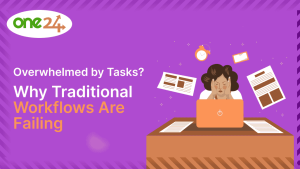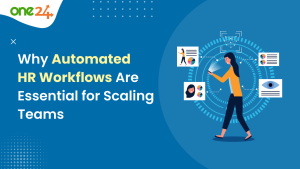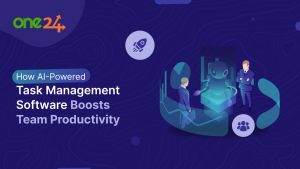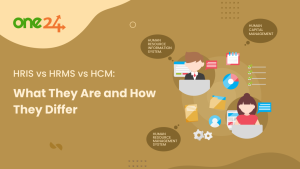Effectively managing the whole employee lifecycle is crucial for organizational success in the fast-paced commercial world. Every phase of an employee’s journey, from the time they first start working for the firm until they leave, has a significant impact on how they perceive their experience and raises morale and productivity levels overall. However, it can be difficult for HR teams to successfully simplify operations due to the frequent inefficiencies and inconsistencies caused by manual processes and heterogeneous platforms.
Introducing One24, a top Organizational Management System (OMS), a complete solution made to streamline and mechanize a number of lifecycle processes. Throughout the entire experience, from onboarding to offboarding, an OMS enables HR professionals to handle every step with ease, increasing productivity, compliance, and employee happiness in the process. In this blog post, we’ll explore how an Organizational Management System eases the employee lifecycle and why it’s essential for modern businesses.

How OMS Simplifies Employee Lifecycle?
1. Onboarding: Creating the Conditions for Achievement
Organizations have their first chance to positively impact and prepare new personnel for success during the onboarding process. However, lengthy orientation sessions, piles of paperwork, and a lack of personalization are common features of manual onboarding processes, which frustrate and distract new hires.
The onboarding process is streamlined by an Organizational management system, which does this by digitizing documentation, automating processes, and giving new recruits individualized welcome experiences. HR departments can use an OMS to develop unique onboarding processes, automate compliance duties like employee handbooks and tax forms, and provide interactive training modules that will assist new hires becomes productive right away.
2. Performance Management: Encouraging Ongoing Development
To ensure that newly hired staff members are successful in their positions, it is crucial to give them regular feedback and assistance. Conventional performance management procedures, such as manual appraisals and annual reviews, are frequently laborious, subjective, and unrelated to daily work.
Performance management is made easier with the help of an Organizational management system, which offers resources for goal setting, progress monitoring, and year-round feedback. An OMS makes it simple for managers to set and assign goals, monitor performance indicators in real time, and give staff members quick feedback. Through the promotion of an open and accountable culture, it enables staff members to take charge of their own professional growth and promote ongoing advancement in their positions.
3. Monitoring Time and Attendance: Ensuring Efficiency and Compliance
An essential component of workforce management is keeping track of employee time and attendance. This helps with scheduling and resource allocation while guaranteeing adherence to labor laws and regulations. Payroll inconsistencies and compliance problems can result from manual timekeeping procedures, such as manual computations and paper timesheets, which are prone to mistakes and inefficiencies.
Time and attendance tracking is made easier with an organizational management system, which automates the recording of staff hours worked, including overtime, breaks, and clock-ins and clock-outs. An OMS lowers the possibility of buddy punching and other time theft techniques by enabling workers to quickly clock in and out utilizing biometric scanners, smartphone apps, or web-based interfaces. Additionally, it provides robust reporting and analytics capabilities, allowing HR teams to track attendance trends, identify potential issues, and ensure compliance with labor laws and regulations.

4. Leave Management: Streamlining Requests and Approvals
Processing leave requests from employees may be laborious and prone to mistakes procedure, particularly for companies with sizable and diverse workforces. Employees and HR departments often experience delays, misunderstandings, and frustration due to manual leave management procedures including paper forms and email chains.
Employees can track balances, seek leaves, and receive fast approvals all from a single, consolidated platform thanks to an organizational management system. They can use it to see their remaining balances in real time, request leaves online, and receive notifications when their requests are granted or denied. It streamlines the leave approval procedure for HR teams, forwards requests to the relevant management for approval, and gives insight into leave balances and utilization throughout
5. Training and Development: Investing in Employee Growth
Developing a trained and motivated staff requires investing in training and development. Traditional training techniques, on the other hand, such as in-person workshops and classroom sessions, may be expensive, time-consuming, and challenging to expand.
By offering a consolidated platform for delivering and monitoring learning activities, an organizational management system streamlines training and development. HR teams may design and administer training programs, monitor completion rates, and evaluate the development and skill of their workforces with this solution. A third-party learning management system (LMS) can also be integrated to offer access to a variety of online materials and courses. This tool enables staff members to learn new skills, improve their performance, and progress their careers within the company by offering accessible and flexible training choices.
6. Offboarding: Concluding the Worker Journey with a Happy Note
Ensuring a seamless and professional offboarding procedure for departing workers is crucial in safeguarding confidential data and maintaining positive working relationships. On the other hand, manual offboarding procedures like gathering equipment and removing access to systems and data can be laborious and prone to mistakes.
Employer management systems streamline the offboarding process by automating processes like asset collection, account de-provisioning, and leave interviews. HR departments may make offboarding checklists, automatically notify pertinent parties, and guarantee that departing employees have a smooth and pleasant experience with the help of an OMS. It also reduces the possibility of data breaches, safeguards business assets, and upholds goodwill with departing staff by optimizing offboarding procedures.
Waving Goodbye
Organizational success in the fast-paced, complicated business environment of today depends on effective management of the full employee lifetime. Every phase of the employee journey, from hiring to firing, has a significant impact on retention, productivity, and experience. However, manual procedures and disjointed systems frequently result in mistakes, inefficiencies, and compliance issues, which compromise HR’s capacity to provide workers with the support they need.
A complete solution for streamlining and automating several parts of the lifecycle, such as hiring and onboarding, performance management, and offboarding, is an organizational management system. HR professionals can improve staff experience, increase productivity, and streamline operations by using this solution, which gives them a consolidated platform to manage employee data, automate repetitive processes, and foster communication and collaboration.
People Also Ask
1. What is an Organizational Management System?
It is a software solution designed to streamline various aspects of the employee lifecycle, including recruitment, onboarding, performance management, time and attendance tracking, leave management, training and development, and offboarding.
2. How does an OMS smoothen the onboarding process?
This platform streamlines the onboarding process by digitizing paperwork, automating tasks, and providing personalized welcome experiences for new hires. It helps HR teams create custom onboarding workflows, automate compliance tasks, and deliver interactive training modules to help new hires get up to speed quickly.
3. What benefits does an OMS offer for performance management?
Performance management is simplified by providing tools for setting goals, tracking progress, and providing continuous feedback throughout the year. It allows managers to easily create and assign goals, track performance metrics in real-time, and provide timely feedback to employees, fostering a culture of transparency and accountability.
4. How does an OMS simplify time and attendance tracking?
Time and attendance tracking is automated to capture the employee work hours, including clock-ins and clock-outs, breaks, and overtime. They can easily clock in and out using biometric scanners, mobile apps, or web-based interfaces, reducing the risk of time theft practices.
5. How does an OMS streamline leave management?
OMS streamlines leave management by providing a centralized platform for employees to submit leave requests, track balances, and receive timely approvals. HR teams can automate the leave approval process, route requests to the appropriate managers for review, and ensure compliance with company policies and regulations.
6. What role does an OMS play in training and development?
This platform provides a centralized platform for delivering and tracking learning initiatives, allowing HR teams to create and assign training courses, track completion rates, and assess employee progress and proficiency. It empowers them to acquire new skills, enhance their performance, and advance their careers within the organization.
7. How does an OMS ease the offboarding process?
The offboarding process is sorted by automating tasks such as de-provisioning accounts, collecting company assets, and conducting exit interviews. HR teams can create offboarding checklists, automate notifications to relevant stakeholders, and ensure that departing employees have a positive and seamless experience.

